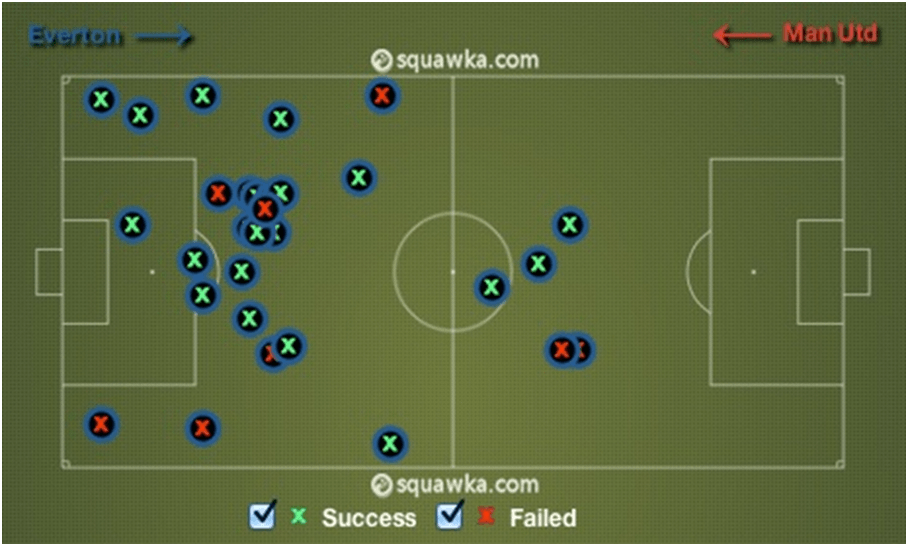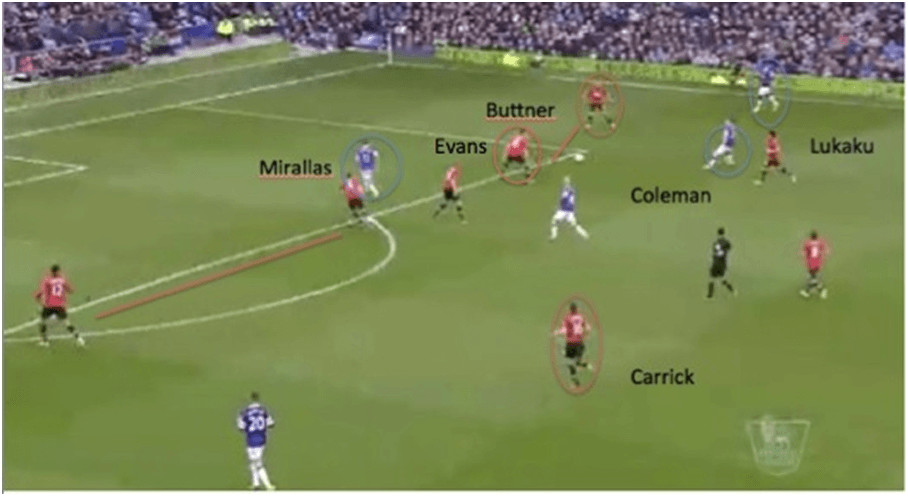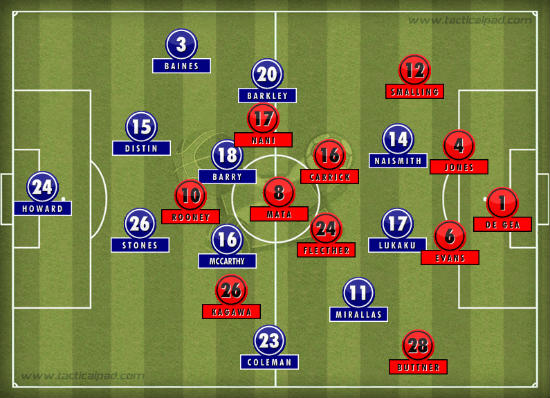It was a must win game for Everton if they wanted to stay in the race for the fourth spot, whereas for United it was more about pride and giving the fans something to cheer for before the end of the season. With Moyes, who returned to his former club, in the dugout, United surely had an extra incentive to win this game. But they didn’t make it count.
Everton lined up with Naismith and Lukaku leading the line and Mirallas and Barkley deeper on either wings. Lukaku played the right-ish role he played against Arsenal and it seemed to work again. Naismith also played a similar role as against Arsenal but was found a bit more deep. Barkley was played on the left, but didn’t look as comfortable as he does in the centre.
Rooney started up front with Kagawa, Mata and the surprise inclusion Nani behind him. Fletcher played instead of Fellaini.
Everton 2-0 Manchester United

Everton: Howard, Stones, Distin (Alcaraz 45′), Coleman, Baines, Barry, McCarthy, Barkley (Osman 70′), Mirallas (McGeady 90′), Naismith, Lukaku
Manchester United: De Gea, Jones, Evans (Hernandez 61′), Smalling, Butter, Carrick, Fletcher, Mata, Nani (Valencia 61′), Kagawa (Welbeck 75′), Rooney
EVERTON APPROACH
The toffees were very robust and strong in their tackles. They looked to win the ball quickly in their defensive third and use Lukaku’s hold- up play and the pace of the wide players and the full backs to counter quickly.

They won 21 of their 30 tackles and the above map shows that it was not desperate last ditch defending but instead they kept United where they wanted and prevented them from penetrating.
If we look at the areas where Lukaku received his passes from, we pretty much understand Everton’s gameplan. Also he was the best player on the pitch in terms of headed duels; winning 6 of 11, more than anyone.
Everton after the initial period of 25-20 minutes or so looked to attack United with 5 players. The front four combined with one full back, usually with Coleman. Baines provide balance on the left and the midfield duo supported possession from deeper positions. Coleman, as said earlier, was the most influential player on the pitch and found the most space. All the balls he put in were very good (below) and rarely wasted an opportunity. He also set up Mirallas with a great through ball.
As discussed earlier Barkley was played on the left rather than his more accustomed central position. He was often found deeper than Baines on that side and appeared to be too cautious with his positioning so as to not take up the space where Baines likes to operate. The action areas of Barkley show the amount of time he spent in deeper positions on the left.
Defensively they were very compact and looked to push the United players to the flank .The back four together defended the centre of the pitch and Barkley and Mirallas guarded the flanks. By doing this they pushed United to the flanks and they couldn’t affect the game from there much. Also by forcing them to go out wide they were able to restrict them space to play as they were guarded by the touch line on one side.
The cross map of United exactly shows why Everton were happy to have them on the flanks. They do not posses the threat from wide areas that they posed under Sir Alex. Also United didn’t have a definite target in the box as with Rooney not strong enough in the air to win against Disitin. And sometimes crosses were targeted to players such as Mata and Kagawa who don’t stand a chance in the air.
EARLY POSITIVE START FROM BOTH SIDES
The game started at a good pace if not frantic. There were no tackles flying in or cards being flashed but there was intent from both sides to have the ball. The reason United dominated possession in the early exchanges of the match was the narrow positioning of Kagawa, Nani and Rooney dropping into midfield.
Both teams held a good defensive line and also left space between the lines. Here players like Kagawa and Mata should have flourished but they were often found deeper than the Everton midfield duo and tried to influence the game from there. Stones did a very good job on Rooney by following him deeper with his back to goal, not allowing him to turn.
The Everton midfielders in the initial stages were not disciplined enough. Sometimes Barry went higher up to close down leaving McCarthy alone in the holding role. Sometimes it was vice versa. Nani moved into that space intelligently but dwelled on the ball too much. Baines didn’t follow Nani inside and left him to Barkley and the midfield to deal with. He focused on Smalling more who made intelligent runs. McCarthy’s athleticism was the key to they way they pressed in the midfield. As the game went on and Everton realized that they had more chances of scoring on the break, they became compact and narrow.
UNITED’S PROBLEMS IN ATTACK
The team in red struggled a lot in this game even when they had the majority on the ball. In the first half they moved the ball well, even though it was sideways. At least they had the confidence in the way they played their passes.
The problem here was that United played in front of Everton too much and when they got a chance to break they simply weren’t fast or incisive enough. Here United played with four players who like to play behind the front man. All of them looked to occupy the same positions on the field.
Also Rooney should have played the role of a forward much better. As mentioned earlier Everton had left a fair amount of space between the lines; so Rooney should have dropped into that space and linked up with Kagawa, Mata and Nani. United’s movement in the final third was very poor. Nobody moved into the space vacated by their teammates. Nobody made runs into the box. Here they needed what they have been missing the most, an energetic midfield runner. Someone who could burst into space and catch the opposition off guard.
Often it was Fletcher who was found in advanced areas and didn’t do enough to create anything. He saw a significant amount of ball in the attacking third but didn’t create anything with his passing or his movement The full backs were poor too in advanced areas with Buttner completing just one cross and Smalling attempting none.
The inclusion of Hernandez on 60 minutes gave United something to aim at. He created a good chance for Ronney with some impressive hold up play but Howard saved excellently.
UNITED’S PROBLEMS IN DEFENSE
The goals were more about the way Everton attacked rather than the way United defended. The pace of their attacks were just too much for United to deal with. Fletcher and Carrick do not have the legs to track back and were often beaten for pace by Naismith and Mirallas. Naismith targeted Carrick really well on the breaks and often looked to draw him in and then turn to burst past him.
The front four didn’t put their shift in defense at all. They missed the energy of Rooney in midfield who would hunt down the ball but instead had to play the role of the front man. Mata and Kagawa didn’t protect their deep midfielders well.
Coleman, who was the best player on the pitch targeted the left side of their defense very well. Also the positioning of Lukaku on that side made it difficult for Buttner to deal with. Coleman often got past Kagawa and put dangerous balls into the box for Naismith. The advanced positioning of Kagawa often meant that Fletcher was drawn towards that side to cover for him leaving them exposed in the middle.
Although Buttner had a good game in terms of tackling, he was very poor in his positional play. He was often found too wide on the right and it only helped Coleman’s cause as he was able to move into the space between him and Jones to cross dangerously.
The utilization of the space between the lines by Everton was far better than their opponents. Here the key role was played by Lukaku and Naismith. The latter is not the fastest in the league but certainly had an advantage over Carrick and Fletcher in terms of pace as mentioned earlier. Lukaku was again brilliant on the day and his hold up play was very impressive. Carrick and Fletcher were often found high up to supplement attacks and this played right into Everton’s hands. [IMAGE BELOW]

The above frame shows the positions of the players 1-2 seconds before Lukaku took the shot which led to a handball and a subsequent penalty which was converted. Here the positioning of the full backs is faulty as they are so high up that they can’t be captured in the frame. As mentioned earlier the position on the midfielders especially Fletcher is too high and thus weren’t able to cope with the counters.

The frame shows the position of the ‘back 6’ when Mirallas was put through by Coleman who finished with finesse. Here, the gap between Evans and Buttner is too much. It was maybe because of the presence of Lukaku on the right made Buttner stay wide; but he should have been narrower and prevented such a huge gap for a ball to be played through. Or, Smalling could have come a bit narrow and the backline could have shifted to that side and prevented space. Also Carrick is found so high up the pitch when the ball is played. You know your team is in trouble when your holding player is in line with your attacking midfielder when you are defending.
WHERE DOES THIS LEAVE THEM?
This game seemed to decide the fate of Moyes as a number of rumours came up after the match suggesting that he might be shown the door. The performances they have put in this season, with a few exceptions, have really been disappointing. They probably should have waited until the end of the season before taking a decision, but this result was the tipping point for Mr. Moyes.
For Everton on the other hand, they have a lot to play for and are completely behind their boss Roberto Martinez, as he looks to drive Everton into the Champions League at Arsenal’s expense, knowing it’s not all in his hands.
For more Tactical Analysis of the biggest games, head this way.



























































